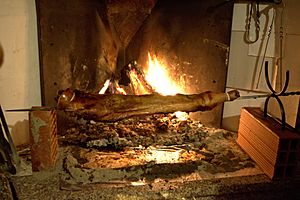Suckling pig facts for kids

A suckling pig is a very young piglet. It is still drinking its mother's milk. These piglets are usually between two and six weeks old. People often cook them whole, usually by roasting them. This dish is popular in many different cultures around the world. It is often prepared for special parties and celebrations.
The meat from a suckling pig is light in color and very soft. When cooked, its skin becomes crispy. This crispy skin can be used to make pork rinds. The meat itself can have a slightly wobbly or jelly-like texture.
Contents
History of Suckling Pig
People have been cooking suckling pigs for a very long time. There are old recipes from Ancient Rome and China. Pigs were among the first animals that humans raised for food. Because of this, pigs appear in many old stories and laws.
For example, a suckling pig is mentioned in a law from the 500s called the Salic law. This law talked about punishments for stealing. If someone stole a suckling pig, they would have to pay a fine. This shows how important these animals were, even in ancient times.
Suckling Pig Dishes Around the World
Suckling pig is prepared in many different ways across Western and Asian countries. One of the most famous ways to cook it is in Segovia, a city in northern Spain.
Spanish-Speaking Countries
In many Spanish-speaking countries, the dish is called Lechón. The word "lechón" comes from the Spanish word "leche," which means "milk." This name reminds us that the piglet is still very young and drinks milk.
Lechón is a popular food in places like Spain, Cuba, Puerto Rico, Argentina, and the Dominican Republic. In Spain, people often use the name cochinillo asado for roasted piglet. Lechón is usually made all year round for special events and festivals.
Asia
In Asia, roast suckling pig is a favorite at important parties. You can often find it in Chinese or Vietnamese restaurants. It is also a popular dish at wedding dinners. Sometimes, it is served at a party to celebrate a baby's first month of life.
In the Philippines, which was once a Spanish colony, lechón is considered a national dish. Here, "lechón" can mean any roasted pig. But if you want a suckling pig, you would ask for lechón de leche. This is similar to the Spanish term cochinillo.
Some groups in Indonesia also enjoy suckling pig. These include the Balinese, Batak, and Minahasa people. Their pork dishes are sometimes influenced by Chinese cooking styles.
European Countries
Many European countries also love suckling pig. These include Romania, Portugal (where it's called leitão), Germany, Austria, Italy, and Serbia. In Russia and Serbia, it is a traditional Christmas meal, often served with goose. The Russian Navy even has a tradition of giving roast piglets to ship crews returning from duty.
In Germany and Austria, suckling pig is known as Spanferkel. It can be roasted in an oven or grilled. It is often served at big celebrations like Oktoberfest.
In Sweden, suckling pig is called spädgris. It is usually cooked in the oven. Sometimes, it is roasted over an open fire. People often stuff it with fruits like apples and plums, along with butter and breadcrumbs.
United States
Suckling pig is also used in Cajun cuisine in the southern U.S. The town of Mansura, Louisiana, even holds an annual festival called Cochon de Lait. During this festival, suckling pigs are roasted. Other ways to cook suckling pig in the U.S. include slow roasting in an oven. It can also be cooked in a pit, like in a Hawaiian-style pig roast. This pit-roasting method is still popular in the cuisine of the Southern United States.
Images for kids
See also
 In Spanish: Lechón para niños
In Spanish: Lechón para niños


